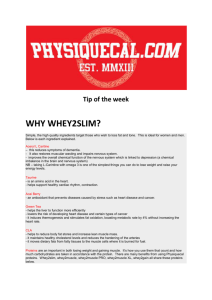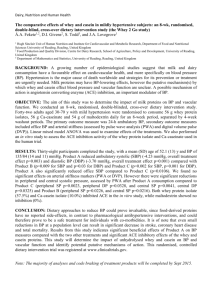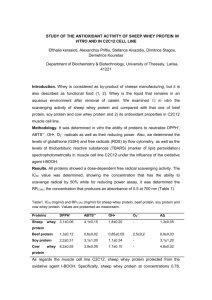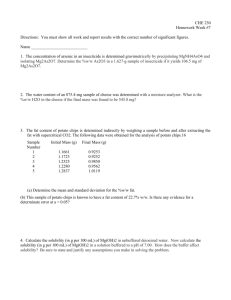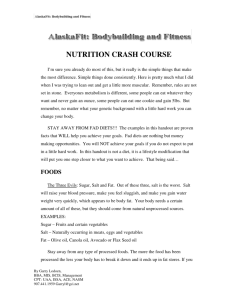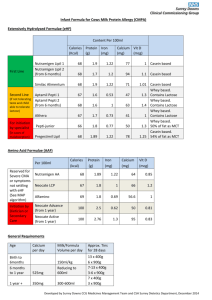Application of Whey Protein and Whey Protein Isolate as
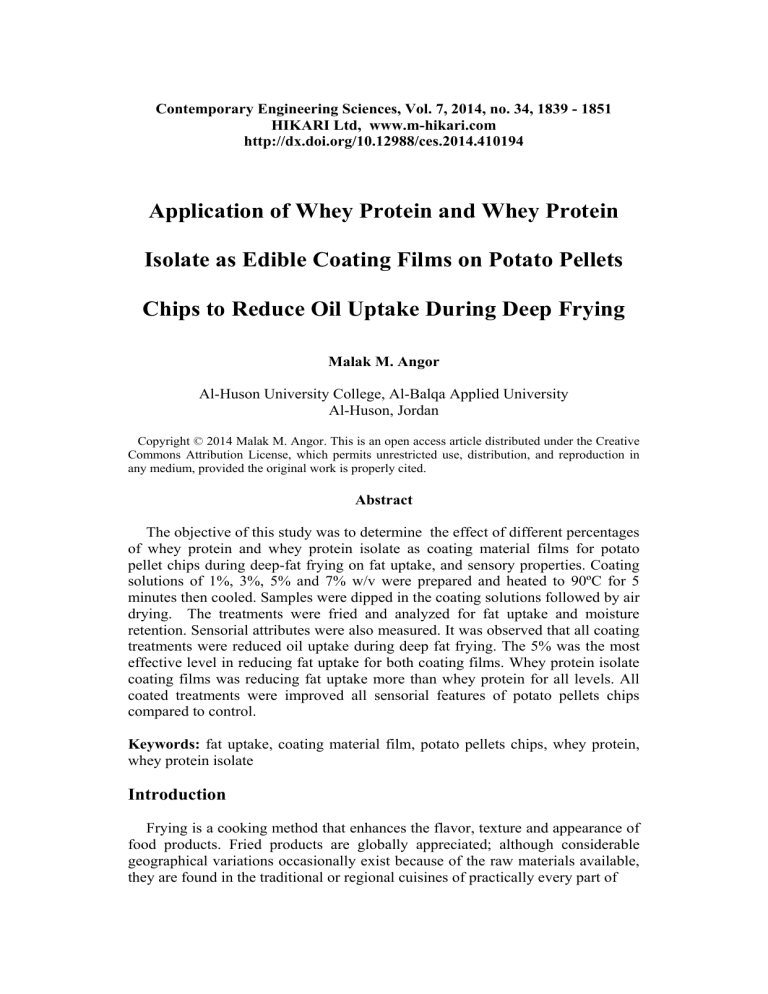
Contemporary Engineering Sciences, Vol. 7, 2014, no. 34, 1839 - 1851
HIKARI Ltd, www.m-hikari.com http://dx.doi.org/10.12988/ces.2014.410194
Application of Whey Protein and Whey Protein
Isolate as Edible Coating Films on Potato Pellets
Chips to Reduce Oil Uptake During Deep Frying
Malak M. Angor
Al-Huson University College, Al-Balqa Applied University
Al-Huson, Jordan
Copyright © 2014 Malak M. Angor. This is an open access article distributed under the Creative
Commons Attribution License, which permits unrestricted use, distribution, and reproduction in any medium, provided the original work is properly cited.
Abstract
The objective of this study was to determine the effect of different percentages of whey protein and whey protein isolate as coating material films for potato pellet chips during deep-fat frying on fat uptake, and sensory properties. Coating solutions of 1%, 3%, 5% and 7% w/v were prepared and heated to 90ºC for 5 minutes then cooled. Samples were dipped in the coating solutions followed by air drying. The treatments were fried and analyzed for fat uptake and moisture retention. Sensorial attributes were also measured. It was observed that all coating treatments were reduced oil uptake during deep fat frying. The 5% was the most effective level in reducing fat uptake for both coating films. Whey protein isolate coating films was reducing fat uptake more than whey protein for all levels. All coated treatments were improved all sensorial features of potato pellets chips compared to control.
Keywords: fat uptake, coating material film, potato pellets chips, whey protein, whey protein isolate
Introduction
Frying is a cooking method that enhances the flavor, texture and appearance of food products. Fried products are globally appreciated; although considerable geographical variations occasionally exist because of the raw materials available, they are found in the traditional or regional cuisines of practically every part of
1840 Malak M. Angor the world. In addition, worldwide fast food companies serve literally tons of fried foods such as French fries, fried chicken, nuggets, onion rings, etc. One of the main problems associated with fried food is its high oil content; as a result, owing to its association with the high incidence of diseases such as obesity, high cholesterol levels or high blood pressure (Varela and Fiszman 2011).
Furthermore, lipid oxidation during frying generates different oxidation byproducts, some of which are also associated with many diseases such as premature aging, membrane damage, heart disease and cancer. Thus, fried foods have become a health concern (Falguera et al. 2011). Health authorities and the media advise of the desirability of reducing the proportion of fat in the average diet. The concern to develop healthier products that contain less fat, absorbed during industrial pre-frying and frying processes, is one of the dominant factors in the latest research prompting studies of ways to lower the oil content of fried food.
Different ingredients have been proved to be effective in reducing the amount of oil absorbed by fried food. Among these using an aqueous solution forming what is generally known as an ‘edible coating films’ on the food to be fried
(Mellema 2003). Properties of fried food surfaces are significant in influencing fat absorption. Application of coating is therefore a promising route to reduce oil content (Ngadi et al.
2007). Coatings are reported to form barriers to moisture loss and subsequently fat uptake during frying (Salvador et al . 2008).
It has been well documented that edible coatings applied to food before frying aid in limiting moisture and oil transfer during frying (Albert and Mittal 2002).
Various surface coating materials such as protein, powdered bread crumbs, starch, carrageenan, and their combinations were used to reduce moisture loss and fat uptake of chicken meat balls during deep fat frying (Al-Abdullah et al.
2011).
Protein films : In their native states, proteins generally exist as either fibrous proteins, which are water insoluble and ser ve as the main structural materials of animal tissues, or globular proteins, which are soluble in water or aqueous solutions of acids, bases or salts and function widely in living systems (Scope
1994). Fibrous proteins are fully extended and associated closely with each other in parallel structures, generally through hydrogen bonding, to form fibers.
The globular proteins fold into complicated spherical structures held together by a combination of hydrogen, ionic, hydrophobic and covalent (disulfide) bonds.
Several globular proteins, including wheat gluten, corn zein, soy protein, and whey protein, have been investigated for their film properties (Bourtoom 2008).
However, there is no published information about the use of whey protein and whey protein isolate as coating materials to reduce moisture loss and fat uptake of potato pellet chips during deep-fat frying. Therefore, the aims of this study are to study the effect of different percentages of whey protein and whey protein isolate as coating material films for potato pellet chips during deep-fat frying on the level of fat uptake and sensory properties.
Application of whey protein 1841
Materials and Methods
Materials
The coating materials used were whey protein (Gainland Chemical Company,
U.K.) and isolated whey protein ( Protient, U.S.A.), glycerine (Fisher Scientific).
Potato pellet chips (JOPELLETS, Amman, Jordan) and corn oil for frying (Yara oil, Kafak Trading Company, Jordan) were purchased from a local market.
Coating solution preparation
Coating solutions were prepared. For each coating material, four solutions of
1%, 3%, 5% and 7% w/v were prepared. Each solution was heated to 90ºC for 5 minutes then cooled to room temperature, after that glycerin was added at a level of 4% w/v to these solutions as plasticizer (Freitas et al.
2009). Potato pellet chips were dipped for 10 seconds in the coating solutions followed by air drying using an air blower; the dipping and drying procedures were repeated again to ensure uniform coating of the film on the products. Potato pellet chips was treated in the same procedure without using coating materials used as control.
Frying
Samples coated and uncoated were deep-fat fried in a commercial electrical deep-fat fryer (Emjoi power, Model UEDL- 206, China) containing 2 liter corn oil
(Yara oil, Kafak Trading Company, Jordan) at 180 ± 2°C for 10 seconds. A digital thermocouple (K- type, APPA-51, Taiwan) was connected to the fryer to control the temperature of the frying oil while a golden color surface of the samples product were controlled by controlling the time of fryer timer. Used oil was replaced by fresh oil after four frying batches (García et al.
2002). In each batch, twenty potato pellet chips were placed inside the frying basket. Frying was carried out by immersing the basket in the oil. After frying, samples were placed on absorbing paper towels for 5 minutes prior further test. This was done to minimize the absorption of oil due to the cooling down period (Southern 2000). The fried samples were left to cool down to ambient conditions for 1 hour. One part of the freshly fried samples was taken immediately for sensory evaluation, while the other parts were placed in plastic bags until chemical and physical analysis. All experiments were run in duplicate and the present results are the average of the obtained results.
Samples analysis
The moisture and the fat contents were determined, according to Association
Official Analytical Chemists (AOAC) 2000 and each analysis was carried out in duplicate.
1842 Malak M. Angor
Moisture content was determined by an oven-drying method in which potato pellet chips samples were placed in dishes and held in an oven (Memmert, 854,
Schwapach, Germany) at 105 o C until constant weight was reached.
Fat content was determined by the Soxhlet method, which involve continuous vaporisation and condensation of petroleum ether during passage through a 5 g, moisture-free sample placed in the extraction thimble and covered with cotton wool. After 16 h, the extract was collected and subjected to distillation in order to collect the crude fat, which was then dried and weighed.
The data for fat and moisture were compared by calculating the fat uptake relative variation% (FU) and moisture retention relative variation% (MR) in the coated product relative to the uncoated one were calculated according to García et al. (2002) as follows:
Acidity percent (as oleic acid) and peroxide value were analyzed for frying oil at each frying batch according to AOAC (2000).
The acidity and peroxide value for the frying oil were ranged from 0.22 to 0.25 and 9.9 to 9.96, respectively.
The volume of each sample was determined by immersion in a graduated cylinder filled with paraffin. Sample specific volume was calculated by dividing the sample weight by the volume of paraffin displaced (Akdeniz et al . 2006).
Thirty panels, chosen from the employees and students of the Department of
Applied Science, Al-Huson University Collage at Al-Balqa’ University were evaluated Samples from each treatment for sensory evaluation. The panellists were of both sexes and different ages (18-50 years). Before evaluating the samples, they were familiarised with the test procedure and use of the scoring system.
Samples were scored for general appearance, colour, flavor, taste, crispiness and overall acceptability, using a descriptive nine-point hedonic scale on which 9 was ‘like extremely’ and 1 was ‘dislike extremely’. Mineral water was provided to rinse the mouth between samples to neutralise any lingering taste from the previous sample. All treatments were evaluated in duplicate on separate occasions.
Statistical analysis
Statistical analysis of data was carried out using Statistical Analysis System package (SAS Inc., 1997). The data obtained were analyzed using a Completely
Randomized Design (CRD) to study the effect of treatments on the fat %, moisture %, fat uptake %, moisture retention%, specific volume, and sensory scores. The significant difference of the mean was determined using Least
Significant Difference (LSD) method.
Application of whey protein 1843
Results and Discussion
Whey protein was selected from different experiments done for different deepfried products. The effect of different concentration of whey protein coating films
(1% , 3%, 5% and 7% ) and control on fat and moisture percent for deep fried potato pellets chips were ranged from 19.9 to 39.49 % and 1.05 to 1.93 % respectively ( Table 1 ).
All the treatments of whey protein reduced fat percent significantly ( p ≤ 0.01 ) compared with control. The lowest fat percent was obtained from 5% whey protein coating film concentration compared to all other treatments. Dogan et al .
(2005) concluded that addition of different proteins at different concentrations to the batter decreased the oil content of the final deep-fried product. Less oil absorption may be related to the formation of covalent links within films during heating. Also Varela and Fiszman (2011) reported that using different coating film ingredients have been proved to be effective in reducing the amount of oil absorbed by fried food.
The moisture percent for deep fried potato pellets chips coated with different concentration of whey protein ranged from 1.05 to 1.93%. The control treatment have the lowest moisture content (1.05 %) which have the highest fat content
(39.49%) , while the highest moisture content ( 1.93 % ) for treatment that contain 7% whey protein have low fat content 24.15 % . and these results might be due to the increase in water-holding capacity and consequently due to prevent of moisture replacement by oil, and this is agreed with Holownia et al.
(2000) who reported that using many edible coating films were reduced fat absorption and improved moisture retention in starchy products and poultry products.
Table 2 shows the results of fat and moisture percent due to using different levels of whey protein isolate (1%, 3%, 5% and 7%) as coating films and control for deep fried potato pellets chips. The fat percent ranged from 18.00 to 39.49% for all treatments. All the treatments of whey protein isolate reduced fat percent significantly ( p ≤ 0.01) compared with control. These results agreed with Albert and Mittal (2002) who concluded that whey protein isolate was very promising as coating material for low fat fried foods. The most effective treatment in reducing fat percent (18.0%) in deep- fried potato pellets chips was 5% concentration whey protein isolate compared to all other treatments. This result agreed with Mah et al .
(2008) who concluded that the highest lipid reduction for breaded and battered fried chicken patties obtained when using 5% whey protein isolate. Moisture content was significantly ( p ≤ 0.01 ) effected increasingly by whey protein isolate coated films for deep-fried potato pellets chips ranged from 1.25 to 1.94% compared to uncoated treatment (1.05% ). The increasing in moisture content and reduction in fat absorption were due to using coating films agreed with that obtained by Freitas et al . (2009).
The influence of different levels of whey protein and whey protein isolate as coating films in reducing fat uptake which led to a higher retention of moisture content for deep fried potato pellets chips (Figure 1).
1844 Malak M. Angor
As moisture content in the coated product was higher than in the uncoated one, the moisture retention was always positive for each coating films whey protein and whey protein isolate which increased in the same trend up to 7% concentration. The fat uptake was always negative because the fat content of the coated sample was lower than the uncoated one. In this work, the lowest fat uptake for whey protein was - 49.95 and for whey protein isolate was – 54.43%.
The most effective reducing fat uptake for both coating films were at level 5%.
Creusot et al. (2011) investigated the effectiveness of whey protein to reduce fat content as an ingredient of coatings. They connected several key points that affect both oil absorption and protein structure, especially in regards to the gel formation. The gel properties of protein gels depend on the structural characteristics of the proteins used (e.g., charge, hydrophobicity). In order to form a gel, the small protein aggregates should cluster together to form larger aggregates that will form a space-filling network.
Whey protein isolate coating films was reducing fat uptake more than whey protein for all levels. Dogan et al.
(2005) reported that, the potential formation of intermolecular disulfide cross-links in whey protein films might have improved the barrier properties of the WPI-added batter for water vapor. The reduced oil uptake may also be related to thermal gelation and the film-forming ability of proteins. The oil content was found to be correlated with the moisture content
(r=0.89). Previously, a linear relationship between oil uptake and water removal had been reported (Dogan et al . 2005). Dragich and Krochta (2010) concluded that whey protein isolate film combination gave good fat reduction in the fried product,. They hypothesis that the whey protein isolate film modifies the surface structure of the product by filling pores in the surface which would otherwise provide a route for oil ingress. Alternatively ,the larger moisture content of the whey protein isolate film increases the surface tension with the oil, contributing to less fat uptake. Also Salvador et al.
(2008) reported that, the fact that water vapor leaves voids in which the fat subsequently enters is the reason why fat uptake is largely water retention properties. García et al . (2002) reported that the reduction in oil uptake and moisture loss to the formation of a protective layer on the surface of the samples during the initial stages of frying due to thermal gelation. This protective layer inhibits the transfer of moisture and fat between the sample and the frying medium. Coating integrity is an important factor because the presence of cracks may reduce barrier properties of coatings and may limit coating applications.
The specific volume ranged from 2.59 to 2.71 g ml -1 for coated and uncoated treatments. There were no significant (P > 0.05) differences between all treatments in specific volume for fried potato pellet chips. This may reflect that the coated films did not affect the specific volume of the treatments. These results confirmed by (Al-Abdullah et al . 2011).
Sensorial characteristics of the marketed materials are attractive to the consumers. Descriptive nine-point hedonic scale for appearance, color, flavor, taste, crispy, and overall acceptability of the control (uncoated), whey protein and
Application of whey protein 1845 whey protein isolate as coating films for deep fried potato pellets chips are shown in Table 3 and table 4.
All coated treatments (whey protein and whey protein isolate) were improved all sensory attributes score compering to the control. The scores of appearance and color of the coating samples with whey protein (Table 3) ranged from 7.65 to 8.2 and 7.9 to 8.3 respectively, and they were found between the ranges of like very much to like. This may be due to the factor that most people like potato pellets chips at different range of color, there were no significant ( p > 0.05) differences between them, while the scores for these treatments were higher than control.
Tran et al . (2007) reported that color is important factor in the qualified processing of French fries and potato chips. The brown color of potato chips is formed by a reaction between reducing sugars and amino acids. These authors reported that this brown color of French fries and potato chips is formed when the moisture content decreases to below 6–12%. Kilincceker et al . (2009) concluded that the mean color values in the coated samples were higher than those of the uncoated fillets.
García et al.
(2002) also concluded that all samples that were coated were accepted by the panelists.
The other attributes scores of flavor, taste and crispy of the coating samples with whey protein (Table 3) were ranged from 7.2 to 8 , 7.2 to 8.45 and 7.6 to 8.2 respectively, there were no significant ( p > 0.05) differences between them, while the scores for these treatments were higher than control. These results were agreed with Kilincceker et al.
(2009), they concluded that the smell, taste and flavor of the samples were improved by using coating materials compared to uncoated sample, and the desired color formed.
The overall acceptability scores of the coated samples with whey protein
(Table 3) were found between the ranges of like very much to like, while the uncoated sample had the lowest value score for overall acceptability compared to all coated treatments, but the differences between all treatments of potato pellets chips for overall acceptability were small. These results were agreed with
Salvador et al.
(2008), they concluded that the differences between the coated and uncoated samples were generally small but significant in some cases. Kilincceker et al . (2009) concluded that the sensorial features of the product were improved and the sensorial properties of the coated fillets were more desirable than those of the noncoated fillets.
All sensory attributes had the best score at 5% concentration of whey protein as a coating film compared to all treatments. The Sensorial characteristics for all treatments of whey protein isolate film (Table 4) had nearly the same trend as whey protein coating films for deep fried potato pellets chips (Table 3). Dragich and Krochta (2010) concluded that the whey protein isolate coated fried chicken shows promise in its ability to stand up to rigorous sensory evaluation. Also
Jooyandeh (2011) reported that whey protein isolate as edible coatings film can improve appearance of a product by adding color or gloss, making it more appealing to consumers.
1846 Malak M. Angor
Conclusions
Using whey protein and whey protein isolate in different concentration as coating films for potato pellets chips were reduced oil uptake during deep fat frying. The most effective level in reducing fat uptake for whey protein was (-
49.95 %) and for whey protein isolate was (- 54.43%) at 5% for both. Whey protein isolate coating films was reducing fat uptake more than whey protein for all levels.
A sensory evaluation on quality of the products is important. All coated treatments were improved all sensorial features of potato pellets chips compared to control.
References
[1] N. Akdeniz, S. Sahin and G. Sumnu, Functionality of batters containing different gums for deep-fat frying of carrot slices , J of Food Eng, 75 (2006), 522–
526. http://dx.doi.org/10.1016/j.jfoodeng.2005.04.035
[2] B. AL-Abdullah, M. Angor, K. AL-Ismail, and R.
Ajo, Reducing fat uptake during deep-frying of minced chicken meat-balls by coating them with some hydrocolloids materials, Ital. J. Food Sci, 23 ( 2011), 331 - 337.
[3] S. Albert and G. Mittal, Comparative evaluation of edible coating to reduce fat uptake in a deep-fried cereal product, Food Res Int, 35 (2002), 445 - 458. http://dx.doi.org/10.1016/s0963-9969(01)00139-9
[4] AOAC. Official methods of analysis (17 th ed.), DC: Association of Official
Analytical Chemists, Washington, 2000.
[5] T. Bourtoom, Edible films and coatings: characteristics and properties, IFRJ
15 (2008) ,237 - 248.
[6] N. Creusot, P. A. Wierenga, M. C. Laus, M.Giuseppin and H. Gruppen,
Rheological properties of patatin gels compared with beta-lactoglobulin ovalbumin, and glycinin, Journal of the Science of Food and Agriculture, 91
)2011), 253-261. http://dx.doi.org/10.1002/jsfa.4178
[7] S. Dogan, S. Sahin and G. Sumnu, Effects of batters containing different protein types on the quality of deep-fat-fried chicken nuggets, Eur Food Res
Technol, 220 ( 2005), 502 – 508. http://dx.doi.org/10.1007/s00217-004-1099-7
[8] A. Dragich, and J. Krochta, Whey protein solution coating for fat-uptake reduction in deep-fried chicken breast strips, J Food Sci, 75 (2010 ), S43 - S47. http://dx.doi.org/10.1111/j.1750-3841.2009.01408.x
Application of whey protein 1847
[9] V. Falguera, J. Quintero, A. Jiménez, J. Muñoz and A.
Ibarz , Edible films and coatings: Structures, active functions and trends in their use , Trends Food Sci
Technol, 22( 2011), 292- 303. http://dx.doi.org/10.1016/j.tifs.2011.02.004
[10] D. Freitas, S. Berbari, P. Prati, F. Fakhouri, F. Queiroz and E.Vicente,
Reducing of fat uptake in cassava product during deep-fat frying, J Food Eng,
94( 2009), 390–394. http://dx.doi.org/10.1016/j.jfoodeng.2009.04.005
[11] M. García, C. Ferrero, N. Be´rtola, M. Martino, N. Zaritzky, Edible coatings from cellulose to reduce oil uptake in fried products, Innov Food Sci Emerg, 3
(2002), 391 – 397. http://dx.doi.org/10.1016/s1466-8564(02)00050-4
[12] K. Holownia, M. Chinnan, M. Erickson, and P. Mallikarjunan, Quality evaluation of edible film – coated chicken strips and frying oils, J Food Sci, 65
(2000), 1087 - 1090. http://dx.doi.org/10.1111/j.1365-2621.2000.tb09423.x
[13] H. Jooyandeh, Whey Protein Films and Coatings: A Review, PJN, 10 (2011),
296 - 301. http://dx.doi.org/10.3923/pjn.2011.296.301
[14] O. Kilincceke, I. dogan and E. Kucukoner, Effect of edible coatings on the quality of frozen fish fillets, LWT-Food Sci Technol, 42 ( 2009), 868 – 873. http://dx.doi.org/10.1016/j.lwt.2008.11.003
[15] E. Mah, J. Price and R. Brannan, Reduction of oil absorption in deep-fried, battered, and breaded chicken patties using whey protein isolate as a postbreading dip: effect on lipid and moisture content, J Food Sci, 73 (2008), S412-S417. http://dx.doi.org/10.1111/j.1750-3841.2008.00902.x
[16] M. Mellema, Mechanism and reduction of fat uptake in deep-fat fried foods,
Trends Food Sci Technol., 14 ( 2003), 364 - 373. http://dx.doi.org/10.1016/s0924-2244(03)00050-5
[17] M. Ngadi, Y. Li and S. Oluka, Quality changes in chicken nuggets fried in oils with different degrees of hydrogenation, LWT-Food Sci Technol , 40 ( 2007),
1784-1791. http://dx.doi.org/10.1016/j.lwt.2007.01.004
[18] A. Salvador, T. Sanz and S. Fiszman, Performance of methyl cellulose in coating batters of fried products, Food Hydrocolloid, 22 ( 2008), 1062 - 1067. http://dx.doi.org/10.1016/j.foodhyd.2007.05.015
[19] SAS, SAS User’s Guide in Statistics, (7 th edition), SAS Institute, Inc.; Cary,
NC, U.S.A, 1997.
[20] K. Scopes, Separation by precipitation, In Protein purification; Principles and practice , ( R.K. Scopes, eds.), pp. 71-101, Springer-Verlag, New York, 1994.
1848 Malak M. Angor http://dx.doi.org/10.1007/978-1-4757-2333-5_4
[21] C. Southern, X. Chen, M. Farid, B. Howard and L. Eyres, Determining internal oil uptake and water content of fried thin potato crisps, Food Bioprod
Process, 78 ( 2000), 119 – 125. http://dx.doi.org/10.1205/096030800532851
[22] T. Tran, X. Chen and C. Southern, Reducing oil content of fried potato crisps considerably using a ‘sweet’ pre-treatment technique, J Food Eng
, 80
(2007), 719 – 726. http://dx.doi.org/10.1016/j.jfoodeng.2006.06.031
[23] P. Varela and S. Fiszman, Hydrocolloids in fried foods. A review, Food
Hydrocolloid, 25 (2011), 1801 - 1812. http://dx.doi.org/10.1016/j.foodhyd.2011.01.016
Table 1 . fat and moisture content of different levels of whey protein as coating films for deep fried potato pellets chips
1
Treatments Fat % Moisture %
1%
3%
31.40
B
28.40 C
1.20
1.50
C
B
5% 19.90
E
24.15
D
1.65
B
1.93
A
7% control 39.49 A 1.05 C
P 2 ** **
1 Values are the means of two replicates, means with different matching letters within the same column are significantly (* ; p ≤ 0.05, **; p ≤ 0.01) different according to LSD.
2 * ; p ≤ 0.05 , ** ; p ≤ 0.01
Application of whey protein 1849
Table 2 . fat and moisture content of different levels of whey protein isolate as coating films for deep fried potato pellets chips
1
Treatments Fat % Moisture %
1% 25.20 B 1.25 D
3%
5%
23.40
C
18.00
D
1.55
1.75
C
B
7% 22.25
C 1.94 A control 39.49
A
1.05
E
P 2 ** **
1 Values are the means of two replicates, means with different matching letters within the same column are significantly
2 * ;
(* ; p ≤ 0.05 , ** ; p ≤ 0.01) different according to LSD. p
≤ 0.05 , ** ; p ≤ 0.01
1850 Malak M. Angor
Table 3. Means of sensory evaluation scores of different levels of whey protein as coating films for deep fried potato pellets chips 1
Treatment s
Appearance Color
1% 7.65
AB
7.90
AB
3%
Flavor
7.20
B
Taste
7.20
BC
Crispy
7.60
A
8.20
A
8.30
A
8.00
A
7.90
AB
8.20
A
Overall acceptability
7.35
8.15
BC
A
5% 8.20
A
8.30
A
8.00
A
7.90
AB
8.20
A
8.20
A
7% 8.10 A 8.20 A 7.20 B 8.45 A 8.10 A 7.90 AB control 7.20 B 7.40 B 6.70 B 6.50
C 6.70 B 6.90 C
P 2 * * ** ** ** **
1 Each mean is the average of 11 readings, where 9 refer to like extremely, 5 neither like or dislike and 1 refers to dislike extremely. Values within the same column followed by different letter are significantly (*
2 ns ; p > 0.05 , * ;
; p ≤ 0.05 , ** ; p ≤ 0.01) different according to LSD. p ≤ 0.05 , ** ; p ≤ 0.01
Application of whey protein and whey protein isolate 1851
TABLE 4.
Means of sensory evaluation scores of different levels whey protein isolate as coating films for deep fried potato pellets chips
1
Treatments
1%
Appearanc e
7.90
AB
Color
8.00
ABC
Flavor Taste Crispy
Overall acceptabili ty
7.10
A
6.90
BC
8.00
A
7.30
BC
3% 8.35
A
8.20
AB
7.20
A
7.00
BC
8.00
A
7.60
AB
5% 8.20
A
8.30
A
7.50
A
8.00
A
8.50
A
8.00
A
7.90
AB
7.60
BC
7.20
A
7.40
AB
8.30
A
7.80
AB
7% control 7.20
B
7.40
C
6.70
A
6.50
C
6.70
B
6.90
C
P 2 * * ns ** ** **
1 Each mean is the average of 11 readings, where 9 refer to like extremely, 5 neither like or dislike and 1 refers to dislike extremely. Values within the same column followed by different letter are significantly (* ; p ≤ 0.05, **; p ≤ 0.01) different according to LSD.
2 ns ; p > 0.05 , * ; p ≤ 0.05 , ** ; p ≤ 0.01
Received: September 5, 2014; Published: December 5, 2014
